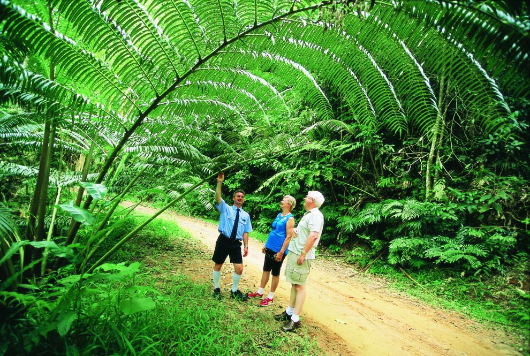
King ferns, tree ferns, tassel ferns....
- Wet Tropics Management
- Legislative framework
- Management partnerships
- Sustainable Tourism Plan
- Threats to the Area
- Research and a Learning Landscape
- How can I help?
 While many of the plants in the rainforest have been around for millions of years, ferns have been around for much longer than that! They appeared in the fossil record dating back to 325 million years ago. They are one of the earliest vascular plant forms on the planet (plants which circulate water internally) and they preceded the flowering plants, the conifers and even the cycads, all of which have a more advanced means of reproduction. There are 40 species of ferns endemic to the Wet Tropics (occur nowhere else) including many interesting species—a few special ones are profiled here.
While many of the plants in the rainforest have been around for millions of years, ferns have been around for much longer than that! They appeared in the fossil record dating back to 325 million years ago. They are one of the earliest vascular plant forms on the planet (plants which circulate water internally) and they preceded the flowering plants, the conifers and even the cycads, all of which have a more advanced means of reproduction. There are 40 species of ferns endemic to the Wet Tropics (occur nowhere else) including many interesting species—a few special ones are profiled here.
The king fern (Angiopteris evecta) looks superficially more like a palm crown growing directly out of the ground but this is actually a relic fern from the late Paleozoic era. This is the only species from its genus in Australia but it does occur elsewhere in southeast Asia/Oceania. The fronds might be the longest in the world for a fern, reaching as much as 5m (16.5 feet). A good place to see king ferns is along the road to Cape Tribulation, and the Nandroya Falls track in the Palmerston section of Wooroonooran National Park (south of Cairns).
Promotional photographs of the Wet Tropics often feature the tree fern, a species which imparts a tropical yet ancient feel to the area. Tree ferns have been here since the dinosaurs but the modern species are only small versions of their ancestors. The scaly tree fern (Cyathea cooperi) is an attractive and characteristic tree fern with its node scars (scales) covering its narrow trunk and horizontal crown of feathery fronds. The crown is said to reach up to 12m (40 feet) wide and sits atop a thin trunk reaching up to 12m (40 feet) tall. This species isn't restricted to the Wet Tropics and can be found in forests further down the east coast of Australia.
 A primitive looking fern indeed is the tassel fern and with good reason—its fossils have been identified to much larger specimens from the Carboniferous period. Two very different forms of the tassel fern are almost opposite to each other in habit. The first is a ground-creeping version sometimes called the pine tree fern (Lycopodiella cernua) as it resembles miniature pine trees only 25cm (10 inches) tall. It prefers open sun and spreads along the ground, sending up vertical stems from along its length. If any of the tips of the erect fern should meet the soil, a new plant sprouts from the tip and grows upward to become a new vertical plant that sends out creepers. Visitors to the Flecker Botanic Gardens in Cairns can see this plant on display.
A primitive looking fern indeed is the tassel fern and with good reason—its fossils have been identified to much larger specimens from the Carboniferous period. Two very different forms of the tassel fern are almost opposite to each other in habit. The first is a ground-creeping version sometimes called the pine tree fern (Lycopodiella cernua) as it resembles miniature pine trees only 25cm (10 inches) tall. It prefers open sun and spreads along the ground, sending up vertical stems from along its length. If any of the tips of the erect fern should meet the soil, a new plant sprouts from the tip and grows upward to become a new vertical plant that sends out creepers. Visitors to the Flecker Botanic Gardens in Cairns can see this plant on display.
The other tassel fern group of interest is an epiphytic one (grows on top of another plant but is not parasitic) which has been grown frequently as a hanging plant. The common tassel fern (Huperzia phlegmaria) likes warm, humid conditions with good air flow. At the end of each long 'cat-tail' is a shorter green stem with tiny cones along its length. These contain the material for a most interesting means of reproduction: the cones release spores which drop into water, some spores being male and others being female. These spores are then fertilised in the water as they collide, becoming a seed which can then sprout a new plant.